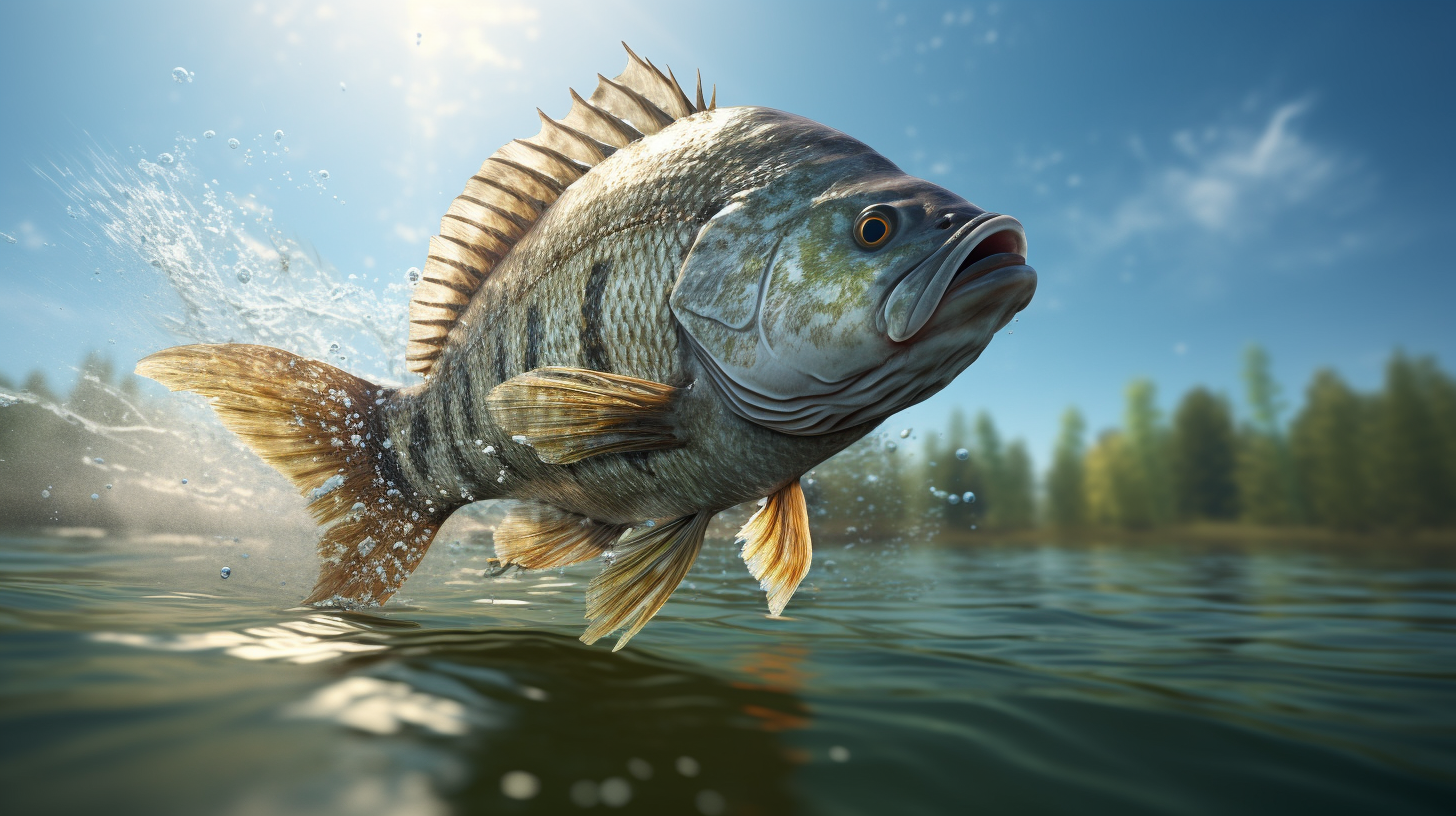Panfish are a popular group of freshwater fish that are loved by anglers all over the world. This group of fish includes species such as Bluegill, Crappie, and Sunfish, and they are known for their delicious taste, aggressive fighting style, and beautiful appearance. Panfish are also relatively easy to catch, making them a great choice for beginners and experienced anglers alike.
One of the reasons why panfish are so popular is their wide range of habitats. These fish can be found in lakes, ponds, rivers, and streams all over North America. They prefer to live in areas with plenty of cover, such as weed beds, submerged logs, and other structures. This makes them a favorite target for anglers who enjoy fishing with live bait or lures.
Key Takeaways
- Panfish are a popular group of freshwater fish that includes species such as Bluegill, Crappie, and Sunfish.
- They can be found in a wide range of habitats, including lakes, ponds, rivers, and streams.
- Panfish are relatively easy to catch and are a favorite target for anglers who enjoy fishing with live bait or lures.
Habitat
Panfish are a group of small, freshwater fish that are commonly found in North America. They are typically found in shallow, weedy areas of lakes, ponds, and slow-moving rivers. These fish prefer water that is warm and clear, with plenty of vegetation for cover and food.
Bluegill, crappie, and sunfish are all panfish that can be found in similar habitats. Bluegills are often found in clear, shallow water with plenty of vegetation, while crappie prefer deeper water with submerged structures like logs, rocks, and plant life. Sunfish, on the other hand, can be found in a variety of habitats, including lakes, rivers, and streams.
Read More OutdoorGoodness Articles
In addition to vegetation, panfish also require clean water with plenty of oxygen. They are sensitive to pollution and changes in water temperature, so they are often used as an indicator species for water quality.
Panfish are also known to be opportunistic feeders, meaning they will eat a variety of food sources depending on what is available. Bluegills, for example, feed on insects, small fish, and crustaceans, while crappie and sunfish primarily feed on smaller fish and aquatic invertebrates.
Overall, panfish are adaptable fish that can be found in a variety of habitats throughout North America. They are an important part of the aquatic ecosystem and are popular among anglers for their small size and delicious taste.
Diet
Panfish, which include Bluegill, Crappie, and Sunfish, are omnivorous and have a diverse diet that changes throughout the year. They feed on a variety of prey, including insects, crustaceans, small fish, and plant material.
During the spring and summer months, panfish primarily feed on insects, such as mayflies, caddisflies, and midges. They also feed on zooplankton and small crustaceans, like daphnia and copepods. In the fall, panfish switch to a more carnivorous diet and feed on small fish, such as minnows and shiners.
In the winter, panfish become less active and feed less frequently. They tend to feed on small invertebrates, such as insect larvae, and may also consume plant material, like algae and aquatic vegetation.
It’s important to note that the specific diet of panfish can vary depending on the body of water they inhabit. For example, Bluegill in a lake may feed on different prey than Bluegill in a river or stream. Additionally, the availability of prey can also impact the diet of panfish.
Overall, understanding the diet of panfish is important for anglers looking to catch them. By using bait and lures that mimic their natural prey, anglers can increase their chances of success.
Fishing Techniques
When it comes to catching Panfish, there are several effective fishing techniques to use. Here are some of the most popular:
1. Using live bait
Live bait is one of the most effective ways to catch Panfish. Bluegills, Crappies, and Sunfish are all known to be voracious eaters, and they will readily take a variety of live baits, including worms, crickets, and minnows. When using live bait, it’s important to use the right size hook and to keep the bait moving to attract the attention of nearby fish.
2. Jigging
Jigging is another popular technique for catching Panfish. To jig, you’ll need a small jig head and a soft plastic or feathered lure. Cast the lure out and let it sink to the bottom, then twitch the rod tip to make the lure move up and down. This motion mimics the movement of small baitfish or insects, which can attract the attention of nearby Panfish.
3. Drop Shotting
Drop shotting is a technique that’s especially effective for Crappie fishing. To drop shot, tie a small hook to your line and attach a weight a few inches below it. Drop the weight to the bottom and slowly lift and lower the rod tip to make the bait move up and down. This technique can be very effective for catching Crappies that are holding near the bottom.
4. Fly Fishing
Fly fishing is a fun and challenging way to catch Panfish. To fly fish for Panfish, you’ll need a lightweight fly rod and a variety of small flies. Cast the fly out and let it land gently on the water’s surface, then use a slow, steady retrieve to make the fly move through the water. This technique can be especially effective for catching Bluegills and Sunfish.
Overall, there are many effective techniques for catching Panfish. By experimenting with different baits and techniques, you can find the method that works best for you and increase your chances of landing a big catch.
Tackle and Gear
When it comes to catching Panfish, using the right tackle and gear is crucial to your success. Here are some key items to consider when selecting your tackle and gear:
Rod and Reel
A light or ultralight spinning rod and reel combo is ideal for Panfish. A 5-6 foot rod with a fast action and light power is perfect for casting small lures and jigs. Look for a reel with a smooth drag system and a high gear ratio to help you reel in your catch quickly.
Line
Choose a lightweight monofilament or fluorocarbon line in the 2-6 lb test range. These lines have less visibility in the water and are more sensitive to bites, allowing you to detect even the slightest nibble.
Lures and Baits
Panfish are known to go after a wide variety of lures and baits, including jigs, spinners, soft plastics, and live bait such as worms or crickets. When selecting your lures, choose small sizes in natural colors such as brown, green, and black. Adding a bit of scent to your bait can also help attract more fish.
Accessories
Don’t forget to bring along some essential accessories such as a landing net, pliers, and a tackle box to keep your gear organized. A pair of polarized sunglasses can also help reduce glare and make it easier to spot fish in the water.
By using the right tackle and gear, you can increase your chances of catching Panfish and have a more enjoyable fishing experience.
Regulations
When it comes to fishing for panfish, it is important to be aware of the regulations set by your state or local government. These regulations are put in place to protect the fish populations and ensure that fishing remains a sustainable activity for years to come.
Some states have specific seasons for panfish, while others allow fishing year-round. It is important to check the regulations for the specific waters you plan to fish, as there may be special season dates or size limits in place.
For example, in Wisconsin, there are exceptions to the general panfish regulations, and anglers must consult the special county regulations in the current hook and line or trout regulations guides to determine if any special season dates exist for the particular waters they plan to fish.
Similarly, in Minnesota, there are specific regulations for panfish bag limits, with a maximum of 10 sunfish allowed in possession, of which no more than five may be crappie.
It is also important to note that some states may have restrictions on the type of bait or lures that can be used to catch panfish. For example, in Nebraska, it is illegal to use corn as bait when fishing for panfish.
Overall, it is crucial to be aware of the regulations in your area and follow them to ensure the sustainability of panfish populations and the enjoyment of fishing for generations to come.
Tips and Tricks
If you’re looking to catch more panfish, here are some tips and tricks to help you out:
- Use the right gear: When fishing for panfish, it’s important to use the right gear. A light to ultralight rod and reel combo with four to six-pound test line is ideal. Use small hooks, such as size 6 or 8, and light sinkers or split shot to keep your bait at the right depth.
- Know where to look: Panfish are often found in shallow water near structure, such as weed beds, fallen trees, or docks. Look for areas with cover and use a depth finder to locate schools of fish.
- Use the right bait: Panfish will eat a variety of baits, including worms, crickets, and small minnows. Jigs and soft plastics are also effective. Experiment with different baits to see what works best in your area.
- Fish at the right time: Panfish are most active in the early morning and late afternoon. Fishing during these times can increase your chances of catching more fish.
- Be patient: Panfish can be finicky and may take some time to bite. Be patient and try different techniques until you find what works.
- Practice catch and release: Panfish are a popular game fish, but they are also an important part of the ecosystem. Consider practicing catch and release to help preserve the population for future generations.
By following these tips and tricks, you’ll be well on your way to catching more panfish. Remember to always follow local fishing regulations and practice good fishing etiquette.
Conservation
Conservation efforts for Panfish have been implemented across the United States to maintain healthy populations and ensure sustainable fishing practices. These efforts include regulations on bag limits, size limits, and closed seasons.
For example, in New York State, a special regulation has been implemented for Bluegill, Pumpkinseed, and Redbreast Sunfish. Anglers are allowed to keep up to 15 fish per day, with a minimum size of 8 inches, and no closed season in select waters such as Blydenburgh Lake, Lake Welch, Canadarago Lake, Goodyear Lake, and Saratoga Lake. [1]
Similarly, in Minnesota, there has been a push to reduce the overall bag limit on each species of Panfish to 5 per person per day, with a possession limit of 10 each. This is aimed at reducing the number of fish taken from the water and promoting catch-and-release practices. [4]
Conservation efforts are also focused on protecting the habitats of Panfish. These fish are typically found in shallow, weedy areas of lakes and ponds. Clearing away these areas can negatively impact their populations, as they rely on these habitats for spawning and feeding.
To promote conservation, anglers can take steps to minimize their impact on Panfish populations. This includes properly disposing of fishing line and hooks, avoiding overfishing, and releasing any undersized or unwanted fish back into the water.
By implementing conservation efforts and promoting sustainable fishing practices, we can ensure that Panfish populations remain healthy for generations to come.
Safety
When fishing for panfish, it’s important to prioritize safety to avoid any accidents or injuries. Here are some tips to help ensure a safe and enjoyable fishing experience:
Wear a Life Jacket
Always wear a life jacket when fishing from a boat, especially if you’re not a strong swimmer. Accidents can happen, and a life jacket can save your life.
Be Aware of Your Surroundings
When fishing in a crowded area, be aware of other anglers and their fishing lines. Always cast your line away from other people and boats to avoid tangling lines or hooking someone accidentally.
Use Proper Gear
Make sure to use appropriate gear for the fish you’re targeting. Using a line that’s too light or a rod that’s too weak can result in lost fish, damaged gear, or even injury.
Mind the Weather
Check the weather forecast before heading out and be prepared for any changes in conditions. Lightning, strong winds, and heavy rain can make fishing dangerous and uncomfortable.
Handle Fish with Care
When handling fish, be gentle and avoid squeezing or dropping them. Use a wet towel or gloves to protect your hands and the fish’s slime layer. If you plan to release the fish, do so quickly and carefully to minimize harm.
By following these safety tips, you can enjoy a fun and safe panfishing experience. Remember to always prioritize safety and be aware of your surroundings to avoid any accidents or injuries.
Record Catches
Panfish, including Bluegill, Crappie, and Sunfish, are popular among anglers for their accessibility, taste, and fighting spirit. Many anglers strive to catch the biggest panfish they can find, and some have even set records in the process.
The International Game Fish Association (IGFA) keeps track of world records for various fish species, including panfish. According to the IGFA, the world record for Bluegill is 4 pounds 12 ounces and was caught in Blytheville, Arkansas in 1950.
The world record for Black Crappie is 5 pounds and was caught in Westwego Canal, Louisiana in 2018. The world record for Redear Sunfish is 5 pounds 7 ounces and was caught in Lake Havasu, Arizona in 2011.
In addition to world records, many states have their own records for panfish catches. For example, Nebraska has state records for Bluegill, Green Sunfish, Hybrid Sunfish, Pumpkinseed, Redear Sunfish, and Warmouth. The current state record for Bluegill in Nebraska is 2 pounds 9 ounces, caught in 2009 at a private pond.
It’s worth noting that record catches can be difficult to achieve and may require a combination of skill, luck, and patience. Anglers who are interested in breaking records should research the regulations and requirements for record submissions in their area, as well as practice proper catch-and-release techniques to ensure the fish’s survival.
Overall, record catches can be a thrilling accomplishment for anglers who enjoy the challenge of fishing for panfish. Whether it’s a world record or a state record, catching a big Bluegill, Crappie, or Sunfish can be a memorable experience for any angler.
Popular Destinations
If you’re looking for a great place to catch panfish, there are plenty of options across the United States. Here are some of the most popular destinations:
1. Tennessee Valley Authority Lakes, Alabama
Alabama offers plenty of A-list bluegill fisheries including the Tennessee Valley Authority lakes, where good water quality, high fertility and a fine mix of weed growth and gravel areas fuel healthy ‘gill populations.
2. Lake Oahe, Dakotas
Lake Oahe, part of the Missouri River system, is a popular destination for trophy panfish, including bluegills, sunfish, crappies, and yellow perch.
3. Lake Osakis, Minnesota
Widely considered one of the best panfish lakes in Minnesota, Lake Osakis and its 6,000-acre waters are filled with crappie, bluegill, yellow perch, sunfish, and small bass.
4. Lake Erie, Ohio
Lake Erie is home to some of the biggest bluegills in the country, with fish weighing in at over 2 pounds. Fishermen can expect to catch a mix of bluegills, sunfish, and crappies.
5. Lake Champlain, Vermont
Lake Champlain is a popular destination for panfish, with a mix of bluegills, sunfish, and crappies. The lake is also home to some of the biggest pumpkinseeds in the country.
6. Lake Poygan, Wisconsin
Lake Poygan is a popular destination for panfish, with a mix of bluegills, sunfish, and crappies. The lake is also home to some of the biggest pumpkinseeds in the country.
Whether you’re looking for a trophy bluegill or just a fun day on the water, these destinations are sure to provide a great experience for any panfish angler.
History and Culture
Panfish, including Bluegill, Crappie, and Sunfish, have a rich history and culture in North America, particularly in the United States. These small, freshwater fish have been important to both Native American and European American cultures for centuries.
Native Americans used panfish as a food source, and also incorporated them into their spiritual and cultural practices. For example, the Ojibwe tribe considered the Bluegill to be a sacred fish, and believed that it possessed healing powers.
European American settlers also relied on panfish as a source of food, and developed various methods for catching and cooking them. Panfish were often caught using simple fishing gear such as hooks and lines, and were often cooked by frying them in a pan.
Today, panfish remain an important part of North American fishing culture. They are popular with recreational anglers, who enjoy catching them for sport as well as for food. Panfish are also an important component of many freshwater ecosystems, and are often used as indicators of water quality.
In addition, panfish have become a popular subject of study for scientists and researchers. They are used as model organisms in a variety of fields, including ecology, genetics, and behavior. Their small size, ease of care, and rapid reproductive rates make them ideal for laboratory studies.
Overall, panfish have a long and fascinating history in North America, and continue to play an important role in our culture and ecosystem.
Future Outlook
The future outlook for Panfish is promising. The Big Panfish Initiative Study Plan, 2021-2026, conducted by the New York State Department of Environmental Conservation (DEC) aims to improve the management of Panfish populations.
The study will help to determine the effectiveness of new regulations that were put in place in 2022. The regulations include a reduced daily limit for Panfish and a prohibition on the use of live baitfish in certain waters. The study will also help to determine the impact of habitat restoration on Panfish populations.
Additionally, the DEC’s Sunfish and Crappie Management Plan proposes management objectives that aim to maintain healthy Panfish populations while also providing recreational opportunities for anglers.
The plan takes into account the opinions of New York anglers and the current science on Panfish management. The plan proposes more conservative sunfish fishing regulations based on results from an online angler survey, which indicate support for such regulations.
Furthermore, experimental bag limits have shown promising results in increasing the size of Bluegills and Crappies. In some lakes, the mean length of Bluegills increased by more than an inch, and the mean length of Black Crappies increased in lakes with a 15/5 bag limit.
These results suggest that bag limits can be an effective tool in managing Panfish populations and improving the quality of fishing.
Overall, the future outlook for Panfish is positive. The efforts of the DEC and other organizations to improve Panfish management and habitat restoration will likely lead to healthier populations and better fishing opportunities for anglers.
Conclusion
Panfish are a diverse group of small freshwater fish that are commonly found throughout North America. Bluegill, crappie, and sunfish are three of the most common panfish species, and they share many similarities in terms of their physical appearance, habitat, and behavior.
Bluegill and crappie are both deep-bodied panfish that have sharp spines on their dorsal and anal fins. They are similarly sized and are both common and widespread throughout North American freshwaters. Sunfish, on the other hand, are typically smaller and more colorful than bluegill and crappie, with a distinctive circular shape and a prominent operculum.
All three species are popular targets for recreational fishing, with bluegill and crappie being particularly prized for their delicious flavor. Bluegill is often considered to be the tastiest of the three, with a firmer and flakier flesh that is more flavorful than crappie or sunfish.
Overall, panfish are a fascinating and important part of North America’s freshwater ecosystems. Whether you are an experienced angler or a curious nature enthusiast, there is much to learn and appreciate about these fascinating little fish.
Frequently Asked Questions
What is the difference between bluegill, crappie, and sunfish?
Bluegill, crappie, and sunfish are all types of panfish, but they have some differences. Bluegill have a rounder body shape, while crappie have a more elongated body. Sunfish are typically smaller than bluegill and crappie. Bluegill and sunfish have a dark spot on their gills, while crappie do not. Sunfish have a more colorful appearance compared to bluegill and crappie.
Which of the three panfish species is best for eating?
Bluegill and crappie are both delicious panfish to eat. Bluegill has a slightly sweeter taste and a firmer texture, while crappie has a softer texture and a more delicate flavor. Sunfish is also edible, but it is smaller and less commonly eaten.
Are bluegill and crappie different types of fish?
Yes, bluegill and crappie are different types of fish. They both belong to the panfish family, but they have distinct physical characteristics and behaviors.
Can you catch bluegill, crappie, and sunfish in the same body of water?
Yes, it is possible to catch bluegill, crappie, and sunfish in the same body of water. They all inhabit freshwater lakes, rivers, and ponds.
What are some common techniques for catching panfish?
Some common techniques for catching panfish include using live bait, such as worms, crickets, or minnows, or using small lures, such as jigs or spinners. Panfish are often caught using a bobber or float to keep the bait at the right depth.
How do you identify the different species of panfish?
To identify the different species of panfish, look for distinct physical characteristics. Bluegill have a round body shape, while crappie have a more elongated body. Sunfish are typically smaller and more colorful. Bluegill and sunfish have a dark spot on their gills, while crappie do not.

Meet Kevin Goodell, your outdoor adventure coach! With a passion for nature ignited in childhood, Kevin brings a wealth of experience and expertise to simplify tough outdoor skills. As a U.S. Army veteran and former Sergeant, he has honed his leadership and teamwork abilities while developing a deep love for the great outdoors.
Kevin’s dedication to outdoor activities spans biking, birdwatching, national park trips, and archery/golf. With his friendly and approachable demeanor, he is committed to guiding individuals of all ages and skill levels towards unforgettable outdoor experiences.
Harnessing his extensive knowledge and personal achievements, Kevin is your go-to resource for learning and enjoying various outdoor pursuits. Whether you seek thrilling adventures or serene nature escapes, Kevin’s professional yet friendly approach will ensure an engaging and informative experience. Embark on your next outdoor adventure with Kevin Goodell and embrace the beauty of nature like never before.






